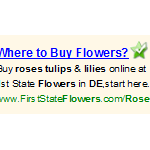How do your paid text ads rank in search results?
You have a paid search engine campaign for your client right? Of course you do. It’s 2012 — how could your client not be present in paid search results?
More and more often, online advertising has come to mean search engine advertising or, more simply, paid text ads that appear in search results. While this has become a staple of online paid media, few companies understand how to write effective text ads. What’s an effective ad? An ideal text ad appears first or second in paid search results and yields a click-through rate ranging from 0.80% to 2.0%.
For many, search engine campaigns are simply built around a list of keywords that they bid on for their text ad to appear in results when those terms are searched. Let’s say you’re selling flowers and you bid on a mix of keywords like “buy flowers,” “flower bouquets” and “florist.” Perfect. So your ad will appear anytime someone searches these terms and you’re going to be a millionaire! Not quite. The chance of your ad appearing in search results depends on more than just your keywords.
When ranking your paid text ad in search results, typical search engine advertising services — such as Google AdWords and Microsoft AdCenter — look at several factors. Some of them may be out of your control, such as a client’s budget and the competition level around your keywords. But there are other major factors that affect your text ad’s position that most tend to ignore:
– the mix of keywords you bid on
– the text ad content (including the URL terms)
– the content of the website the ad is linked to
When you look at these three components, think about relevancy: How relevant your text ad is to your keywords, as well as how relevant the text ad and keywords are to the content of the landing page, are all assessed by a search engine when it decides which ad to choose first.
Here is an example of a mediocre text ad for that kick-ass flower shop. We differentiate the company by bragging about being voted #1 in our local magazine. We offer an incentive to the Internet browser of free shipping and we include a call to action: “Start here.” All good things, right?
| 1st State Flowers |
| Voted #1 by Delaware Today. Order |
| now & shipping is free. Start here: |
| www.FirstStateFlowers.com |
Yes, but this ad fails to acknowledge what the consumer will actually search for when buying flowers. Unless you expect all of your consumers to search for you by company name, this ad will not turn you into a flower tycoon.
By taking five minutes to research flower terms in two of Google’s underused resources, the Google Keyword Tool and Google Insights for Search, you will discover some of the most common terms Internet searchers use when buying flowers.
So, take two. You learn that “where to buy flowers” is one of the most commonly searched terms and some of the most popular flowers are roses, tulips and lilies. You include all of these terms in your text ad. You also know that customers will not be searching for flowers in Delaware by using the term “first state,” so you include “DE.” To increase this ad’s relevancy even more, you include a keyword as an extension of the URL.
| Where to Buy Flowers? |
| Buy roses tulips & lilies online at |
| 1st State Flowers in DE. Start here: |
| www.FirstStateFlowers.com/Roses |
While this ad does not mention being voted #1, its chances of appearing above competitors’ ads are much higher. Once you’ve perfected your keyword-rich text ad, the final step is to ensure that the page the ad is linked to includes all of these vital terms (“buy flowers,” “buy tulips,” etc.) in its content. Once the search engine detects that the keywords, the text ad and the landing page are all relevant to each other, chances are you’ll be seeing your ad appear first and second in search results. And chances are you’ll be making bank selling all these flowers!
Even if you create the most perfect text ads, where they end up is a completely different story. Check out some unfortunate and unintended ad placements by Google here: Google’s Worst Ads Ever.
Sign up to receive our industry trends newsletter:

